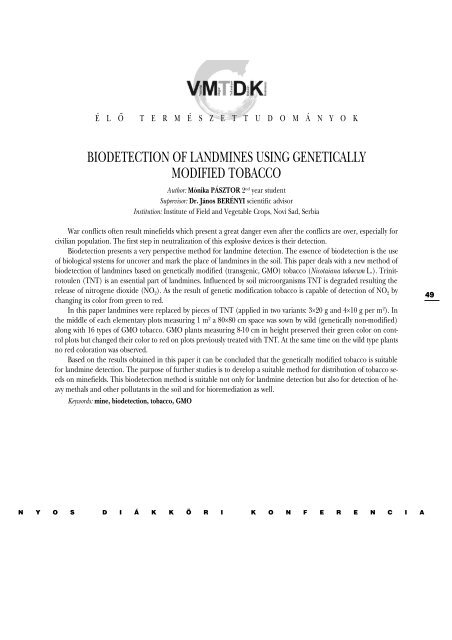Rezümékötet 2008. - vmtdk
Rezümékötet 2008. - vmtdk
Rezümékötet 2008. - vmtdk
Create successful ePaper yourself
Turn your PDF publications into a flip-book with our unique Google optimized e-Paper software.
É L Õ T E R M É S Z E T T U D O M Á N Y O K<br />
BIODETECTION OF LANDMINES USING GENETICALLY<br />
MODIFIED TOBACCO<br />
Author: Mónika PÁSZTOR 2 nd year student<br />
Supervisor: Dr. János BERÉNYI scientific advisor<br />
Institution: Institute of Field and Vegetable Crops, Novi Sad, Serbia<br />
War conflicts often result minefields which present a great danger even after the conflicts are over, especially for<br />
civilian population. The first step in neutralization of this explosive devices is their detection.<br />
Biodetection presents a very perspective method for landmine detection. The essence of biodetection is the use<br />
of biological systems for uncover and mark the place of landmines in the soil. This paper deals with a new method of<br />
biodetection of landmines based on genetically modified (transgenic, GMO) tobacco (Nicotaiana tabacum L.). Trinitrotoulen<br />
(TNT) is an essential part of landmines. Influenced by soil microorganisms TNT is degraded resulting the<br />
release of nitrogene dioxide (NO 2). As the result of genetic modification tobacco is capable of detection of NO 2 by<br />
changing its color from green to red.<br />
In this paper landmines were replaced by pieces of TNT (applied in two variants: 3×20 g and 4×10 g per m 2 ). In<br />
the middle of each elementary plots measuring 1 m 2 a 80×80 cm space was sown by wild (genetically non-modified)<br />
along with 16 types of GMO tobacco. GMO plants measuring 8-10 cm in height preserved their green color on control<br />
plots but changed their color to red on plots previously treated with TNT. At the same time on the wild type plants<br />
no red coloration was observed.<br />
Based on the results obtained in this paper it can be concluded that the genetically modified tobacco is suitable<br />
for landmine detection. The purpose of further studies is to develop a suitable method for distribution of tobacco seeds<br />
on minefields. This biodetection method is suitable not only for landmine detection but also for detection of heavy<br />
methals and other pollutants in the soil and for bioremediation as well.<br />
Keywords: mine, biodetection, tobacco, GMO<br />
N Y O S D I Á K K Ö R I K O N F E R E N C I A<br />
49




